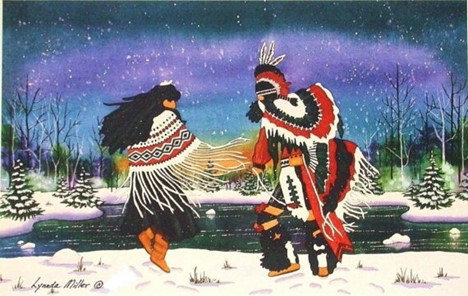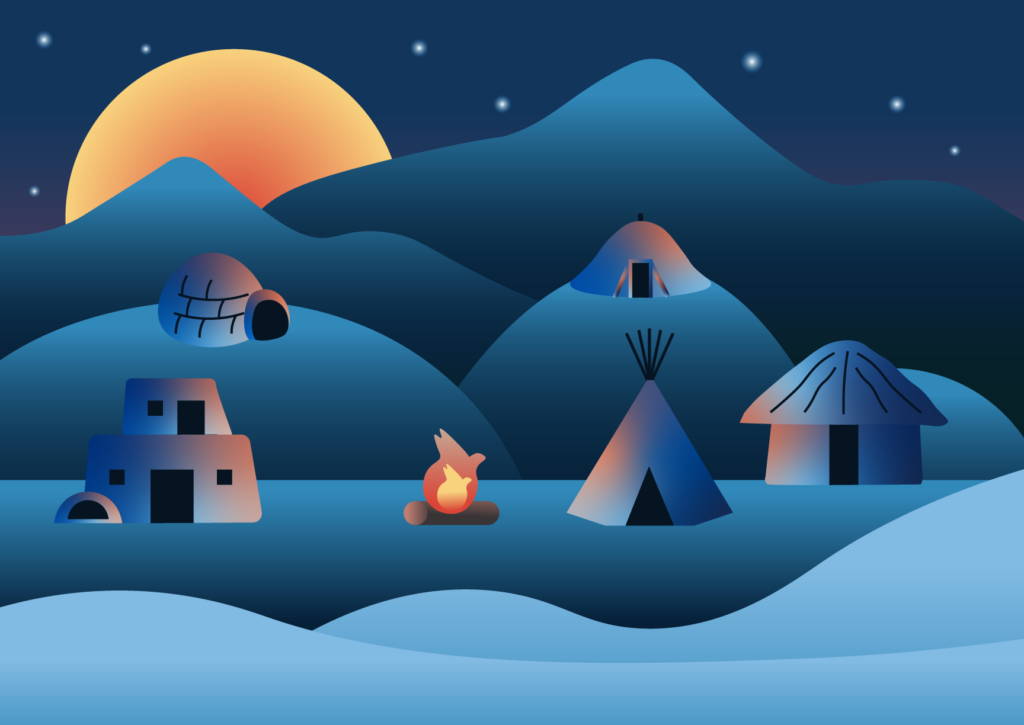Winter solstice: It’s the shortest day of the year, beginning of winter and the storytelling season.
Sep 13, 2018
Original:
Dec 21, 2014

On December 21, just as the evening news is beginning, winter will be upon us.
It’s the shortest day of the year, and at 6:03 p.m. Eastern Standard Time on Turtle Island, Mother Earth will arrive at that point in its orbit that puts the sun as far south on the horizon as it gets, portending winter here but summer in the Southern Hemisphere.
Up in Inuit territory, of course, no one will see this, because the sun will never rise. The South Pole will get all the sun, bathed in light for 24 straight hours. This is what happens when the North Pole is tilted at a 23.5-degree angle away from the sun. At noon, our shadows will be their longest of the year.
For a bit of perspective and a look at Earth’s seasons from space, check out this time-lapse NASA video, courtesy of Earthsky.org.
It’s the start not only of winter, but also of storytelling season. When the sun and other heavenly bodies are sleeping, out of earshot, it is safe to talk about them in most of Indian country—something many cultures have in common.
“When the moon is in a cup shape [horns pointed up] that’s when you have your long winter or very cold nights that are going to happen,” said Rudy Begay, a Navajo cultural specialist, in a 2012 interview with ICTMN. That’s when the storytelling can begin.
“We in the Navajo stories, teaching, is that you don’t talk about certain things which are sacred,” Begay said, “because those, while they’re awake in the summer, they could affect your mind, your body, get you out of balance with nature. So when these animals are asleep, that’s when you talk about astronomy and other things.”
The behavior of the heavenly bodies is normally only talked about during the winter months, said ethnobotanist Arnold Clifford.
“Especially when dealing with the lower world and the upper world,” he said. “You teach it when lightning is asleep, when spiders are asleep, and all the ants are still underground, and all the insects are still underground or in hibernation.”
No wonder all we want to do is curl up under a warm blanket with a good book.

Though it’s the season of darkness, it of course heralds the return of the light, the sun’s rebirth, and the event is widely celebrated.
“Winter-solstice celebrations could well be the world’s oldest holidays,” said Sky and Telescope in 2006. “There are more known rituals associated with this solstice than for any other time of the year.”
RELATED: Winter Solstice: Coaxing and Celebrating the Return of the Light
Turtle Lodge in what is today Canada is holding a solstice gathering this year. And of course, there are the annual celebrations in Stonehenge, England, among the most notable of ancient astronomical sites.
“Traditionally the Original People have always gone into ceremony to celebrate what is considered the longest night—the Winter Solstice,” Turtle Lodge says. “The Winter Solstice gives birth to the New Sun through the longest night of the year. It is during that longest night that we honor our way of life. We follow the New Sun across the sky as it watches over us. It is a time when we would honor our ancestors and what they have left for us. The turtle leaves us a trail to follow, and we are all given a chance to walk that trail. The Winter Solstice is a time when we honor the Trail of the Turtle.”
And there’s an added element that sets this year’s winter solstice apart.
“A fun fact about the coming solstice is that it occurs within about two-and-a-half hours of a new moon,” says Earthsky.org. “No matter where you live on Earth’s globe, a solstice is your signal to celebrate.”
The new moon’s presence has not gone unnoticed in Indigenous circles either, and holds a special significance of its own, the Turtle Lodge said.
“The New Moon reminds us of our children and brings a message of Abinoojii Kagekwewin—a law we are encouraged to implement,” Turtle Lodge said. “Abinooji Kagekwewin means “Education and teachings that are given by Mother Earth, grandmothers, mothers, and women; for the children, that last forever.”


9 Responses
This is real interesting. I knew we only tell stories of creation, only in the winter. I didn’t fully understand why. I love this blog. I learn so much!
PS I’m glad the blog has been fixed. I can now comment. hayu masi
Thank you so much!!!!
This is really interesting. I knew we only tell stories of creation, only in the winter. I didn’t fully understand why. I love this blog. I learn so much!
PS I’m glad the blog has been fixed. I can now comment. hayu masi
This is really interesting. I knew we only tell stories of creation, only in the winter. I didn’t fully understand why. I love this blog. I learn so much!
PS I’m glad the blog has been fixed. I can now comment. hayu masi
Thank you so much!!! masi
Your posts are so thought-provoking and often leave me pondering long after I have finished reading Keep challenging your readers to think outside the box
Thank you so much!!
Give a round of applause in the comments to show your appreciation!
Thank you so much!!